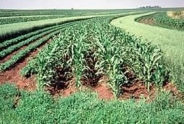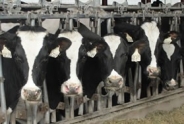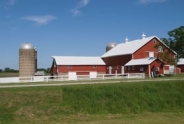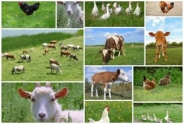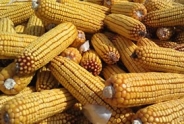Air Fryers - For More than just Chicken Tendies
Katelyn Walley, Business Management Specialist and Team Leader
Southwest New York Dairy, Livestock and Field Crops Program
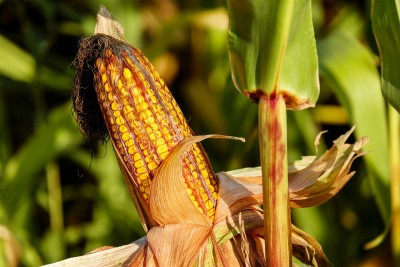
Dry matter is the part of forages or feed after moisture has been removed. The most accurate way to test for dry matter is through a laboratory sample where they use a high-tech "oven" to precisely measure DM. However, there are different ways that DM testing can be done on-farm which helps with making livestock ration changes and determining optimal harvest for quality silage making.
At our Corn Silage Pre-Harvest Meetings in Springville and Arkport this week, speaker Joe Lawrence talked about the importance of monitoring your corn crop's dry matter for optimal harvest and storage. One way to measure dry matter of growing/harvested crops, and even at feed out or a whole TMR, is with the latest trendy kitchen appliance - an air fryer.
Air fryers are small, convection style ovens that "fry" food without using oil. They've recently grown in popularity and are used in the home to prepare things like french fries, doughnuts, bacon, and - my kids' favorite - "chicken tendies". Cooking with convection, hot air is circulated throughout the air fryer to crisp by losing moisture. These are readily available from any box store and online retailers for $50 - $200.
Traditionally, farms use a Koster tester, ranging in price from $400 - $2,000 from various farm supply stores. There are also more expensive options for hand-held near-infared spectroscopy (NIRS). Farms have used regular microwaves as well by microwaving samples for a few minutes (counterintiuitive - but be sure to include a cup of water with your sample to prevent fire/minor explosion). This process, while affordable, is tougher and more involved than an air-fryer or koster tester, requiring a lot of trial and error and (usually) a couple busted up microwaves (sorry, Mom).
How does an air fryer compare to these other methods? Joe Lawrence noted that the air fryer used the same amount of electricity as a traditional Koster tester but its advantages lie in price and decrease in fire risk with it's automatic shut off. It's also a "set it and leave it" process. Accuracy wise, an international group of researchers found that there was no significant difference in accuracy between an air fryer, microwave, or forced air oven.
To use an air fryer to measure DM, based on a 2018 article from Dan Severson of the University of Delaware, you will:
- Weigh out 100 grams of a representative sample of what you're measuring
- Representative = not just two stalks out of the field that you could grab from your truck door. Pick 5 - 10 stalks from a few different spots in the field, or many handfuls from different areas of your TMR for example. If measuring growing forages, be sure to "process" them in some way - send through a chipper, chop a small amount, etc.
- Using an inexpensive kitchen scale works great. You can then cheaply replace it often (those scales that came with your 30 year old Koster tester might be inaccurate enough to really skew your results).
- Place the sample in the air fryer basket (what my kids would call the Chicken Tendie Hot Spa J)
- You'll want to spread it out in a somewhat even layer.
- Set the fryer to 250 degrees F and the timer to 30 minutes.
- Record the weight of your dry sample.
- Use the same scale/tare for your container
- Calculate the DM content
- With a 100 gram sample, you'll: Final Dry Weight (grams) / Initial Wet Weight (grams) X 100 = percent dry matter
- Example: 45 grams dried sample / 100 grams initial wet sample x 100 = 45% DM
You can then use this dry matter to balance your rations, determine harvest windows, and improve your overall forage quality! If you'd like more information or have questions, contact your local Field Crops Specialist. For the SWNY region, we're currently recruiting to fill this position, so contact Katelyn Walley-Stoll, SWNYDLFC Team Leader, at 716-640-0522.
Upcoming Events
WNY Pastureland Conversion & Soil Health Field Day
July 16, 2025
Middleport, NY
Join American Farmland Trust for the Western New York Soil Health Field Day on July 16, 2025, at Zeliff Farm in Middleport, NY, from 9:00 AM-3:15 PM. Learn about pasture conversion, soil health benchmarking, biochar in grazing systems, and best grazing practices. Plus, enjoy hands-on demos with the NY Soil Health Trailer, drones, and cover crops! Check out the attached agenda for more information about the field day and REGISTER HERE. Zeliff Farms is a regenerative beef operation who has recently partnered with AFT on outreach and education to farmers including learning circles and evaluating biochar effects on soil health.
IPM Strategies to Protect Corn and Soybean Seed in NY
July 30, 2025
Hamburg , NY
SWNYDLFC and Cornell IPM are hosting a grower meeting to discuss integrated pest management strategies for protecting corn and soybean seed in New York.
FAMACHA Training for Sheep and Goat producers in Woodhull NY
August 13, 2025 : FAMACHA Training in Woodhull
Woodhull, NY
Join us for a discussion and hands-on training for internal parasite integrated pest management in sheep and goats. Certification is available to all students participating in the workshop.
Announcements
No announcements at this time.

